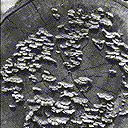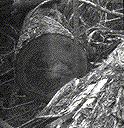Archived Content
Information identified as archived on the Web is for reference, research or recordkeeping purposes. It has not been altered or updated after the date of archiving. Web pages that are archived on the Web are not subject to the Government of Canada Web Standards. As per the Communications Policy of the Government of Canada, you can request alternate formats on the Contact Us page.
Brown Cubical Pocket Rot
Veluticeps fimbriata (Ellis & Everh.) Nakas.
(= Hymenochaete fimbriata Ellis & Everh.)
(= Stereum rugisporum (Ellis & Everh.) Burt)
Basidiomycotina, Aphyllophorales, Corticiaceae
Hosts: In B.C., Veluticeps fimbriata has been reported mainly on western hemlock, amabilis, grand, and subalpine fir, but also on mountain hemlock, Douglas-fir, and Engelmann and Sitka spruce. In other parts of North America it has also been found on western redcedar, white and black spruce, western larch, and pine.
Distribution: This fungus is widely distributed throughout the range of its hosts in B.C.
Identification:The perennial fruiting bodies are small and resupinate or shelf-like with a roughened grey to light brown lower surface and a dark brown to nearly black upper surface. The context is brown. The hymenial surface is smooth to warted, and usually cracked to some extent. Fruiting bodies may form on the scarred faces of living trees but more frequently are found on old logs and dead material on the ground (Fig. 27a).
The early stage of decay is characterized by a wet, dark brown or black stain that occurs in streaks or patches. The advanced stage develops in pockets surrounded by what appears to be sound wood. In the final stage the individual pockets coalesce, forming an almost continuous column of decay (Fig. 27b). The decay is soft and friable and is often associated with dark stain, a thin cobweb-like accumulation of mycelium and an odour resembling that of stored apples.
Microscopic Characteristics: Contextual hyphae in five distinct layers, clamp connections present. Basidiospores ellipsoid to cylindrical, hyaline, but occasionally pale yellow, slightly thick-walled, smooth, IKI-, 11.9-15.5 x 4.7-5.6(-6) µm. Growth in culture very slow, mat becoming brown, reverse brown, conspicuous opaque brown dots in agar, laccase negative, simple septa, globose to oblong chlamydospores. Stalpers: (1) 2 (9) (10) (11) 13 (14) (16) 17 (21) 22 (30) (31) 34 38 (39) (40) 42 45 48 (49) (50) 52 53 (54) (60) 61 67 (72) 75 80 83 85 90 96 98.
Damage:Veluticeps fimbriata was once considered to be only a slash destroyer, but is now recognized as a commonly occurring trunk rot in conifers. The fungus is also capable of continued development in unseasoned timber.
Remarks: Collections of this fungus were previously identified as Columnocystis abietina (= Stereum abietinum Pers.), but a recent taxonomic study by Nakasone (1990) has split the group, and treats the collections from B.C. as V. fimbriata.
References:
Nakasone, K. K. 1990. Taxonomic study of Veluticeps (Aphyllophorales). Mycologia 82: 622-641.
Figures
Click on any image to see the full size version.
Press "Back" on your browser to return to this screen.

Figure 27a: Fruiting bodies of Veluticeps fimbriata on a fallen western hemlock log.
 Figure 27b: Advanced decay of western hemlock caused by V. fimbriata.
Figure 27b: Advanced decay of western hemlock caused by V. fimbriata.
 This Web page has been archived on the Web.
This Web page has been archived on the Web.